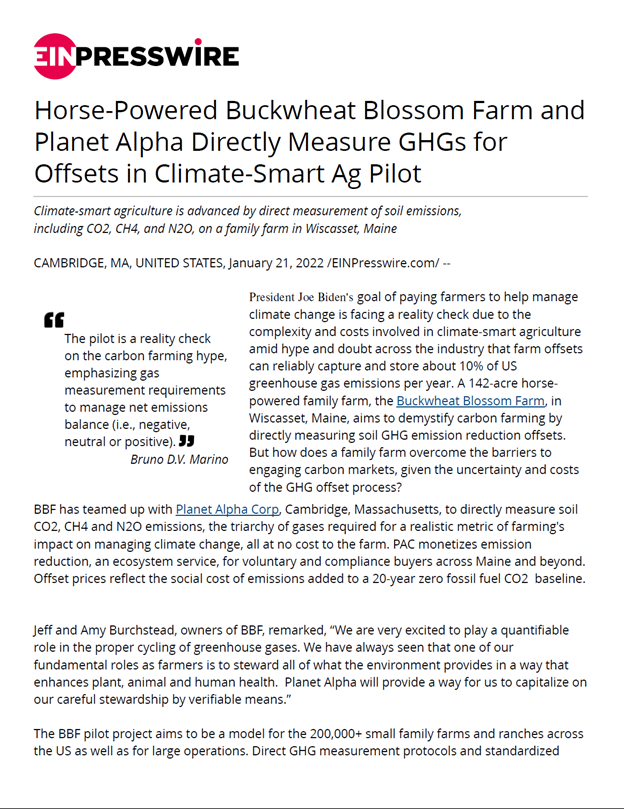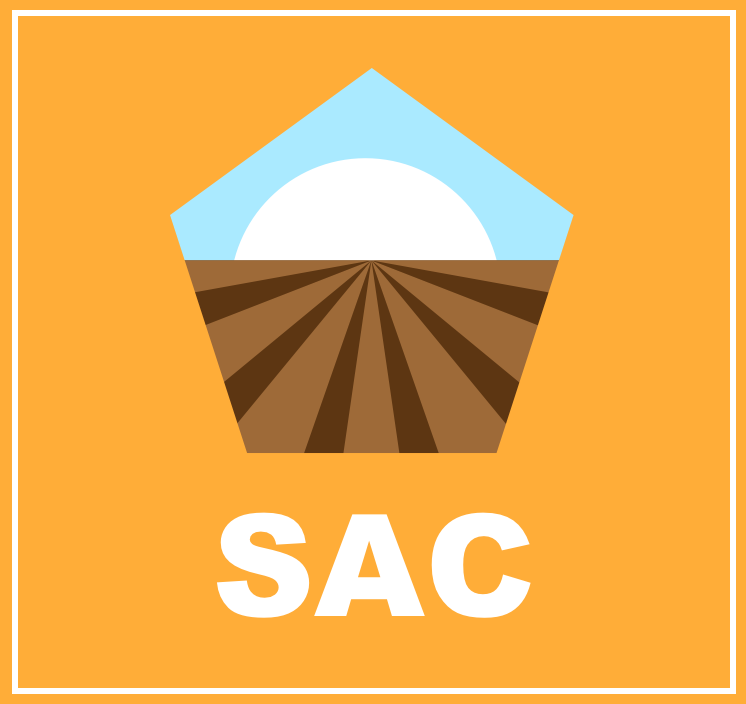Buckwheat Blossom Farm is located in Wiscasset, Maine, set within a natural forested landscape. The farm is dedicated to reducing emissions from fossil-fuel CO2, and farm emissions of CO2, methane (CH4) and nitrous oxide (N2O), and to conserving land while sustaining a business that serves the community.
Buckwheat Blossom Carbon Farming Dashboard
The Harvard Forest Carbon Ticker
Recent daily financial carbon (NEE) per acre from the Harvard Forest, Petersham, MA. The Harvard Forest is a model forest with extensive monitoring for CO2 flux over a 29-year period. The BBF monitoring program will be based on the same methods as employed at the Harvard Forest. The Harvard Forest CO2 flux data is shown here as an example of the type of data that will result from the PAC BBF project.
CO2 $152 per tonne
CO2 $51 per tonne

The carbon ticker from the Harvard Forest is a good example of a forest known to be a sink of carbon. This kind of ecosystem helps to reduce the CO2 concentration in the atmosphere, mitigating the consequences of climate change. The ticker to the left shows the monetary value of this contribution if the tonne of CO2 were valuated at $51 or $152 respectively. These values were estimated as the social cost of carbon (2020) at 3% discount rate, and 3% discount rate 95% percentile were $51 and $152, respectively. Details about this estimation can be found in "Technical Support Document: Social Cost of Carbon, Methane, and Nitrous Oxide. Interim Estimates under Executive Order 13990".

Site location
It's located in Wiscasset, Maine, USA, about 4 km away from Wiscasset, the nearest town. Other big cities close to the farm are Brunswick and Portland (Maine) at 34 km and 75 km away, respectively. It’s near the Pacific Coast (27 km away) and 36 km away from Augusta, the capital of Maine.
Diversification Tables

Project Diversification: Buckwheat Blossom Farm is a small (~142 acre), 10- to 30-year terrestrial project monitoring GHGs directly including CO2 CH4, and N2O in the atmosphere and soils (isotopic species will be added). The risk of carbon pricing is considered low given the small size of the project area. BBF is comprised of value (forests, wetland), blended (silvopasture + forests), and growth (silvopasture) land-use styles. GHG asset class styles consist of value (CO2), blend (CO2, CH4, N2O), and growth (CH4, N2O). GHG pricing (per metric ton) for products ranges from ~$40 to $1,000.
Species Composition
The main species in the Buckwheat Blossom Farm are Hemlock and Pine poletimber, which are a kind of tree with a diameter between 5 to 10 inches (12-25 cm). A smaller proportion of wider trees called sawtimber (over 10 inches wide) can be found inside the farm as Hemlock, Spruce, and Pines. Oak, Maple, and Red Maples of different diameters live in small quantities in the area.
The Intergovernmental Panel on Climate Change Data
The Near Future
From the charts on the left, we see that the temperature will rise around 2°C by 2040, resulting in an annual average temperature of 10°C for the Buckwheat Blossom Farm. By 2100, the increase will be of 6°C, which gives an annual mean temperature of 14°C for the site. Precipitation shows a rise of around 5% and 12% by 2040 and 2100, respectively. In these years, the average annual rainfall will be 1260 mm and 1350 mm in the project area. This extra precipitation may augment the quantity and intensity of floods.
To evaluate the impact of climate change, the IPCC (Intergovernmental Panel on Climate Change) has established many possible future scenarios where humanity has or hasn’t adopted green policies. The “SSP5-8.5” scenario, considers that GHG emissions keep increasing at the current pace with CO2 emissions that roughly double from current levels by 2050. The graphs below show the yearly change in temperature and precipitation estimated by the IPCC in this scenario for the North East of North America.
Buckwheat Blossom Farm high frequency measurements
Yesterday data
Temperature and precipitation
Soon!
Radiation
Soon!
CO2 Flux
Soon!
CH4 Flux
Soon!
Year to date data
Temperature and precipitation
Soon!
Radiation
Soon!
CO2 Flux
Soon!
CH4 Flux
Soon!
PαC Gaia Monitor
Carbon Farming Investment Development Portfolio #1:
Buckwheat Blossom Farm | Northeast US, Wiscasset, Maine, USA
A Horse-powered Family Farm Committed to Reducing Fossil Fuel Emissions Through Sustainable Land Management
20 Years of Horse-Powered Agriculture Enhancing Ecosystem Services for Sustainable Farming
~57.5 hectares (~142 Acres)
Buy Buckwheat Blossom Farms Ecosystem Services Products Here
Overview:
Buckwheat Blossom Farm is located in Wicasset, Maine, set within a natural forested landscape. The farm is dedicated to reducing emissions from fossil-fuel CO2 and to conserving our land while sustaining a business that serves the community.
Buckwheat Blossom Farm (BBF) is unique among farms: fossil-fuel emissions from farm operations have been eliminated. Instead, a culture of horse-powered agriculture practiced for two decades has a net-zero fossil fuel-footprint relative to tractors. The Burchstead family of Wiscasset, Maine, has proven that farm operations and nature can co-exist with social, economic and planetary benefits.
From a carbon farming perspective, horse-powered agriculture, no-till farming, cover crops and sustainable stewardship of the farm ecosystem likely results in increased carbon storage. The farm also cultivates areas of pasture within the forest, a practice know as silvopasture, to humanely raise sheep for wool and food, taking a deliberate “step-back” from large farming operations.
The silvopasture approach means that BBF pastures have never seen sewage sludge deposits and are free of PFAS (forever chemicals) relative to land with a history of sludge application. Jeff Burchstead recommends that a small portion of the abundant forest land in Maine be converted to silvopasture to eliminate PFAS contamination providing a fresh start for affected farms. BBF silvopasture lamb and chickens are available at the Brunswick, Maine, farmers market every Saturday.
The BBF greenhouse gas emissions profile is likely net-negative relative to fossil-fuel CO2 emitting farms and very small compared to methane (CH4) emissions from raising cattle. A horse-powered agriculture framework is a game-changer for soil health and lacking the use of broadcast fertilizers, likely reduces nitrous oxide (N2O) while supporting natural and human selected biodiversity and protection of the local and regional watershed. Planet Alpha will directly measure the GHG emissions of BBF, tracing its biological uniqueness and managing for emission reductions. This is “biotechnology for the biosphere.”
BBF operations result in farm biotechnology offsets (FBOs) available to community small businesses, governments, corporations and individuals signaling support for a legacy of farm conservation in Maine, now and for future generations. The BBF Community action results in tangible benefits that fight climate change. FBO pricing is consistent with the social cost of GHGs and achieving the Paris Agreement temperature target goals of limiting global warming to 1.5° C above preindustrial levels.
Overview:
The project area, covering ~57.5 hectares of land, is located in the New England, USA, region, Wiscasset, Maine. The project area consists of wetland, forest, pasture and silvopasture areas. Silvopasture is the integration of trees and grazing sheep operations on the same land. Silvopasture provides shade, diversification of woodland and resilience for grazing during periods of drought.
- Field Measurements and Methods:
- Up to three Global Monitoring Platforms with CO2 and CH4 Flux Analyzers (Half-Hour Intervals) will be positioned across the project area (SoS, EC).
- An N2O gas analyzer will be deployed at one location after initial setup.
- Isotopic flux (QQ) for CO2 (13CO2, 12C16O18O) and CH4 (13CH4) will be deployed after initial base stations have been established.
- Soil CO2 and CH4 Flux Chambers (SAC), soil gas probes (SGP), flask collection (FC) and isotopic analysis (IA) may augment gas analyzer installations.
- High-resolution project monitoring of forest canopy employing PαC drone fleet (UAS).
- Remote Sensing (RS) Commercial Services:
- Light Detection and Ranging (LIDAR) for determination of standing biomass
- Landsat data for spectral imagery
- GHGsat for methane plume detection, and other available data sets of relevance as applicable.
Biosphere Box Products:
The Biosphere Box products flow from the measurements and methods and will include the full range of projects including active sequestration by improved forest management (IFM), working forests (WF), reforestation (RF) and agroforestry (AGF) and avoided carbon (GHG) emissions from enhancement in biodiversity (B) across the project area.

Gallery

Press Releases

Sheep shearer shows he can cut it at Common Ground Country Fair
This is the first time in about 10 years the fair has featured the ‘vital’ skill, one fewer people are learning.

Jeff Burchstead holds a pair of manual shears Saturday morning during his sheep-shearing demonstration at the Common Ground Country Fair in Unity. Burchstead believes he’s one of only six or seven professional shearers in Maine. Photos by Nikolas Hample

In-Operation
Measurements
Please click on the icons below to see what each measurement signifies.




Sensor Plan:
Installation 1: CO2, CH4 Measurements
Installation 2: N2O
Installation 3: Flask samples for radiocarbon determination by external service.
Methods
Please click on the icons below to see what each method signifies.








Biosphere Box Portfolios
Active Sequestration Box Products
Please click on the icons below to see what each box product signifies.




Avoided Emissions Box Products
Please click on the icons below to see what each box product signifies.


Project Sensor Plan
Pending Review
Project Timeline
Pending Review
Contact Details
Jeff and Amy Bruchstead: buckwheatblossomfarm@gmail.com
Planet Alpha Corp: bruno.marino@planetalphaforest.earth






 Gorilla Habitat (G) Avoided Carbon
Gorilla Habitat (G) Avoided Carbon

 Afforestation (AF) Sequestration
Afforestation (AF) Sequestration





 Exsolvation of Dissolved CO2 (CO2(aqueous)) and CH4
Exsolvation of Dissolved CO2 (CO2(aqueous)) and CH4 Vehicle Mounted Fast Response Gas Analyzers (VM)
Vehicle Mounted Fast Response Gas Analyzers (VM) A variety of UAS’s may be used in a project to record the status of forest conditions at low altitude (e.g., ~1,000 ft) on a routine basis, when a disturbance has occurred (e.g., hurricane, drought, timber operations) or for surveillance of forest activity by landowners or others accessing the site. Typical capabilities may include spectral imaging of the tree canopy and mapping functions to reveal differences along the flight path over time. In addition, UAS’s may also carry miniaturized gas sensors for CO2, CH4 and other atmospheric gases. The use of remote sensing (RS) for ecological research is well documented covering spectral bands for normalized difference vegetation index (NDVI), leaf evapotranspiration and other features of the biotic and abiotic project area.
A variety of UAS’s may be used in a project to record the status of forest conditions at low altitude (e.g., ~1,000 ft) on a routine basis, when a disturbance has occurred (e.g., hurricane, drought, timber operations) or for surveillance of forest activity by landowners or others accessing the site. Typical capabilities may include spectral imaging of the tree canopy and mapping functions to reveal differences along the flight path over time. In addition, UAS’s may also carry miniaturized gas sensors for CO2, CH4 and other atmospheric gases. The use of remote sensing (RS) for ecological research is well documented covering spectral bands for normalized difference vegetation index (NDVI), leaf evapotranspiration and other features of the biotic and abiotic project area. Sulfur Hexaflouride (SF6)
Sulfur Hexaflouride (SF6) Tree Plantation
Tree Plantation Perfluorocarbon (PFC)
Perfluorocarbon (PFC) Water Vapor (H2O)
Water Vapor (H2O)